By Leen Randell
Updated: Jul 19, 2024
10 Best Herbal Creams For Foot Pain
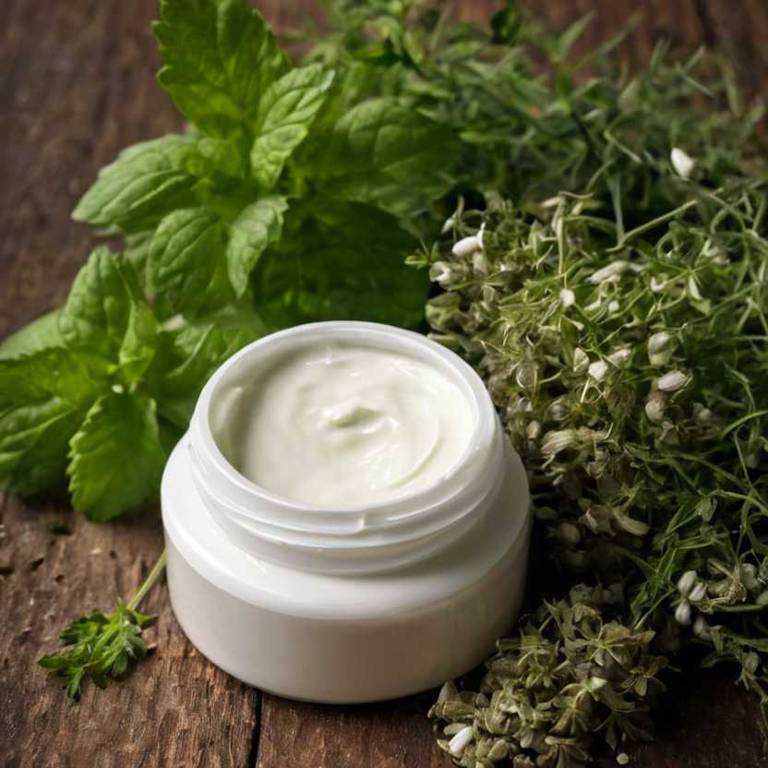
Herbal creams for foot pain are topical ointments infused with natural herbs and essential oils that provide relief from discomfort and inflammation in the feet.
These creams help to reduce pain and promote healing by addressing the underlying causes of foot pain, such as plantar fasciitis or heel spurs.
Examples include creams containing arnica, peppermint, and capsaicin, which have been shown to improve mobility and reduce pain, allowing individuals to engage in daily activities with greater ease and comfort.
The following article describes in detail the most important creams for foot pain, including medicinal properties, parts of herbs to use, and recipes for preparations.
- 1. Artemisia absinthium
- 2. Cinnamomum verum
- 3. Eucalyptus globulus
- 4. Gaultheria procumbens
- 5. Melaleuca alternifolia
- 6. Mentha x piperita
- 7. Myristica fragrans
- 8. Pinus sylvestris
- 9. Salix alba
- 10. Sambucus nigra
- What is the best combination of herbal creams to use for foot pain?
- What ailments similar to foot pain are treated with herbal creams?
1. Artemisia absinthium
Artemisia absinthium, also known as wormwood, creams helps with foot pain because of its anti-inflammatory and analgesic properties.
The active compounds in wormwood, such as thujone and artemisinin, work to reduce swelling and ease pain in the feet. This natural remedy has been used for centuries to treat various types of pain, including arthritis and sprains.
The topical application of wormwood cream allows the active ingredients to penetrate deep into the skin, providing quick relief from foot pain and discomfort.
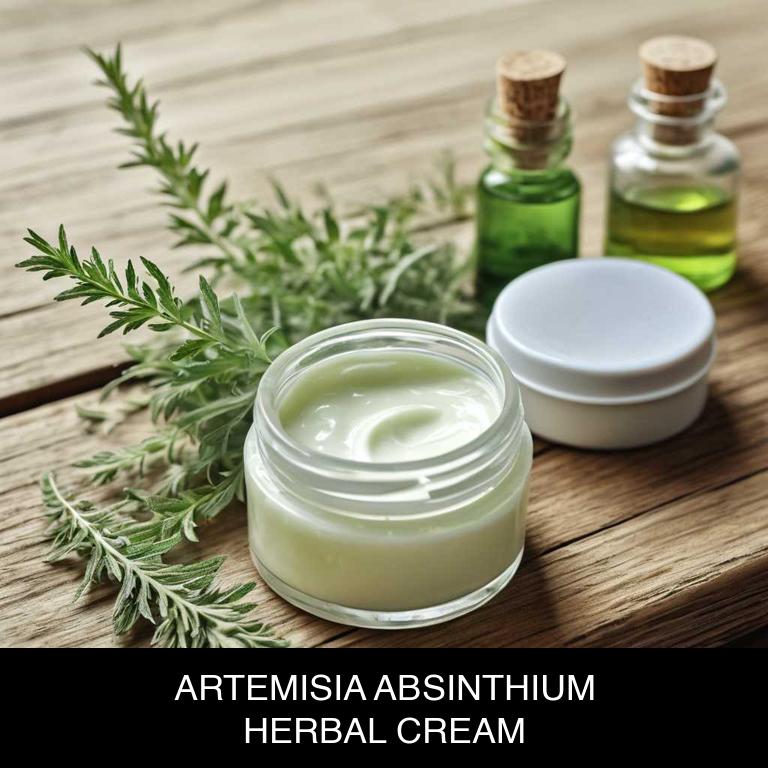
Medicinal Constituents
The list below shows the primary medicinal constituents in Artemisia absinthium creams that help with foot pain.
- Thujone: Thujone has anti-inflammatory and analgesic properties, which help reduce pain and inflammation associated with foot conditions such as plantar fasciitis or heel pain.
- Vitexin: Vitexin has potent anti-inflammatory and antioxidant properties, which may help reduce swelling and pain in the feet, while also promoting wound healing and tissue repair.
- Caffeic acid: Caffeic acid has anti-inflammatory and analgesic properties, which may help reduce pain and inflammation associated with foot conditions such as arthritis or gout, while also promoting circulation and reducing oxidative stress.
Parts Used
The list below shows the primary parts of wormwood used to make creams for foot pain.
- Leaves: They are used due to their anti-inflammatory and antiseptic properties, which help reduce pain and inflammation in the feet.
- Stems: They contain compounds that exhibit analgesic and anti-inflammatory effects, providing relief from foot pain.
- Roots: The roots of Artemisia absinthium are used for their antispasmodic and anti-inflammatory properties, which help soothe and calm foot pain.
Quick Recipe
The following recipe gives a procedure to make a basic wormwood for foot pain.
- Harvest 1/4 cup of dried artemisia absinthium leaves and flowers and clean them thoroughly with a soft brush.
- Steep the cleaned leaves and flowers in 2 cups of carrier oil such as coconut or olive oil for 2 weeks.
- Strain the infused oil from the leaves and flowers through a cheesecloth or a coffee filter into a clean container.
- Mix 1/2 cup of the infused oil with 1/2 cup of beeswax and 1/4 cup of shea butter in a double boiler.
- Whip the cooled mixture with an electric mixer until it thickens and forms a smooth and creamy texture.
2. Cinnamomum verum
Cinnamomum verum, also known as Ceylon cinnamon, creams helps with foot pain because of its anti-inflammatory and antioxidant properties.
The creams often contain essential oils from Ceylon cinnamon, which penetrate deep into the skin to soothe and relax muscles. This can help reduce swelling and ease the tension that causes foot pain. Additionally, the warming sensation of the cinnamon oil can stimulate blood flow, further alleviating pain and discomfort.
This natural remedy can provide relief for individuals who suffer from foot pain due to overuse or other underlying conditions.
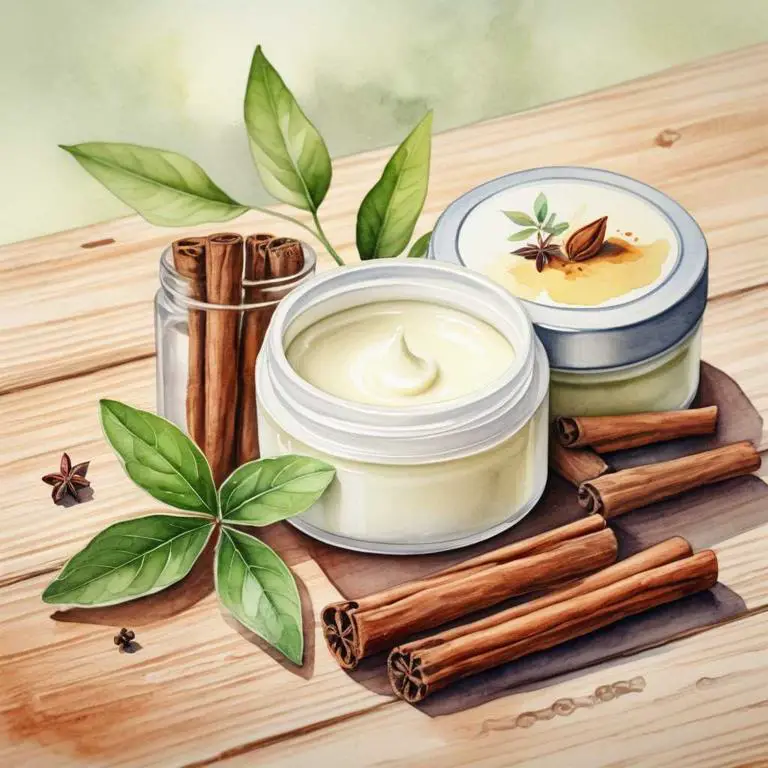
Medicinal Constituents
The list below shows the primary medicinal constituents in Cinnamomum verum creams that help with foot pain.
- Cinnamaldehyde: This phenolic compound has anti-inflammatory and analgesic properties, which help to reduce pain and inflammation associated with foot conditions.
- Cinnamomin: This terpene is known for its anti-inflammatory and antioxidant properties, which may help to soothe and reduce pain in the feet.
- Catechins: These polyphenolic compounds have anti-inflammatory and antioxidant properties, which may help to reduce pain and inflammation in the feet, as well as promote healing and relaxation.
Parts Used
The list below shows the primary parts of ceylon cinnamon used to make creams for foot pain.
- Leaves: The leaves are also used for their analgesic and antispasmodic properties, which provide relief from foot pain and discomfort.
- Rhyzomes: The rhyzomes (or rhizomes) have anti-inflammatory and antiseptic properties that help soothe and reduce pain in the feet.
Quick Recipe
The following recipe gives a procedure to make a basic ceylon cinnamon for foot pain.
- Combine 200g cinnamomum verum essential oil with 100g shea butter in a mixing bowl to blend.
- Heat 100ml coconut oil over low heat for 5 minutes before adding 50g beeswax to melt.
- Allow the coconut oil and beeswax mixture to cool and solidify for 30 minutes to thicken.
- Whip 100g heavy cream with 20g cinnamomum verum essential oil until stiff peaks form quickly.
- Mix the solidified coconut oil mixture with the whipped cream mixture to combine thoroughly.
3. Eucalyptus globulus
Eucalyptus globulus, also known as Tasmanian blue gum, creams helps with foot pain because of its anti-inflammatory and analgesic properties.
The active compounds in Eucalyptus globulus, such as eucalyptol, help to reduce swelling and ease pain in the feet. It also possesses a cooling effect that can help to numb the area, providing quick relief from discomfort.
Regular application of Eucalyptus globulus creams can lead to improved circulation, reduced stiffness, and enhanced mobility, making it an effective remedy for foot pain.
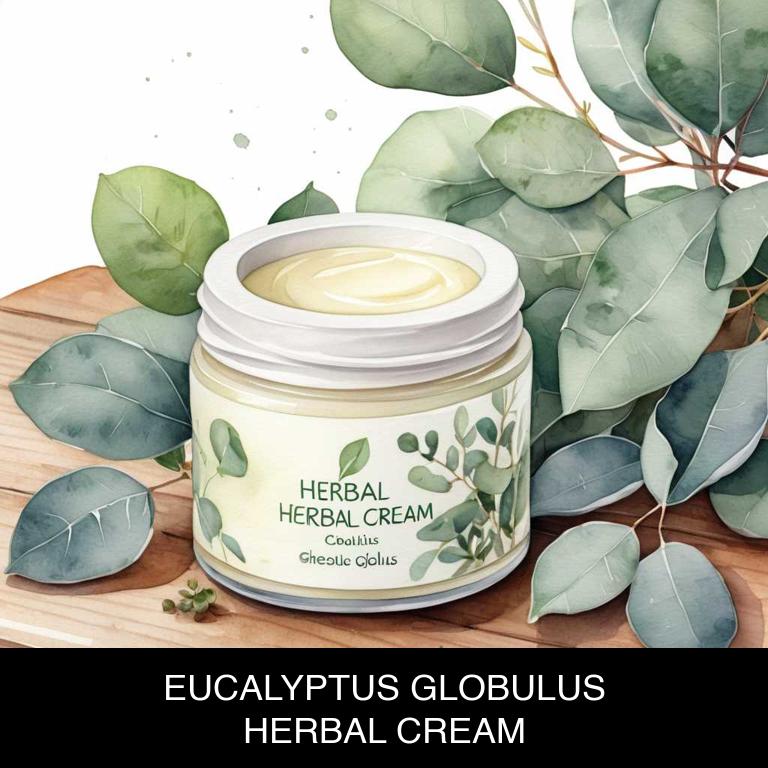
Medicinal Constituents
The list below shows the primary medicinal constituents in Eucalyptus globulus creams that help with foot pain.
- Cineole: Helps reduce inflammation and pain in the foot by acting as a natural analgesic and anti-inflammatory agent.
- Caryophyllene: Acts as a potent analgesic and anti-inflammatory compound, reducing pain and swelling in the foot by inhibiting the production of pro-inflammatory chemicals.
- Α-terpineol: Exhibits anti-inflammatory and analgesic properties, helping to reduce pain and inflammation in the foot by blocking the action of pro-inflammatory enzymes.
Parts Used
The list below shows the primary parts of tasmanian blue gum used to make creams for foot pain.
- Leaves: They contain eucalyptol, a natural analgesic and anti-inflammatory compound that helps relieve pain and reduce swelling.
- Barks: They are rich in tannins, which have anti-inflammatory and antiseptic properties that help soothe and protect the skin.
- Essential oil (derived from leaves): It is often extracted from the leaves and added to creams for its pain-relieving, anti-inflammatory, and antiseptic properties.
Quick Recipe
The following recipe gives a procedure to make a basic tasmanian blue gum for foot pain.
- Gather 250 grams of beeswax and 250 grams of shea butter and melt them in a double boiler for 10 minutes.
- Mix 100 milliliters of eucalyptus globulus essential oil with 500 milliliters of distilled water in a separate bowl.
- Combine the melted beeswax and shea butter mixture with the eucalyptus globulus mixture and stir well for 5 minutes.
- Add 10 grams of vitamin e oil and 5 grams of preservative to the mixture and stir for 2 minutes.
- Pour the mixture into a container and let it cool and solidify at room temperature for 30 minutes.
4. Gaultheria procumbens
Gaultheria procumbens, also known as wintergreen, creams helps with foot pain because of its anti-inflammatory and analgesic properties.
The cream contains methyl salicylate, a natural pain reliever that targets specific pain areas. When applied topically, the cream helps to reduce swelling and ease discomfort in the feet, often associated with conditions such as plantar fasciitis and arthritis.
Regular use of Gaultheria procumbens creams can provide long-lasting relief from foot pain, making it an effective natural remedy for those seeking an alternative to traditional pain management methods.
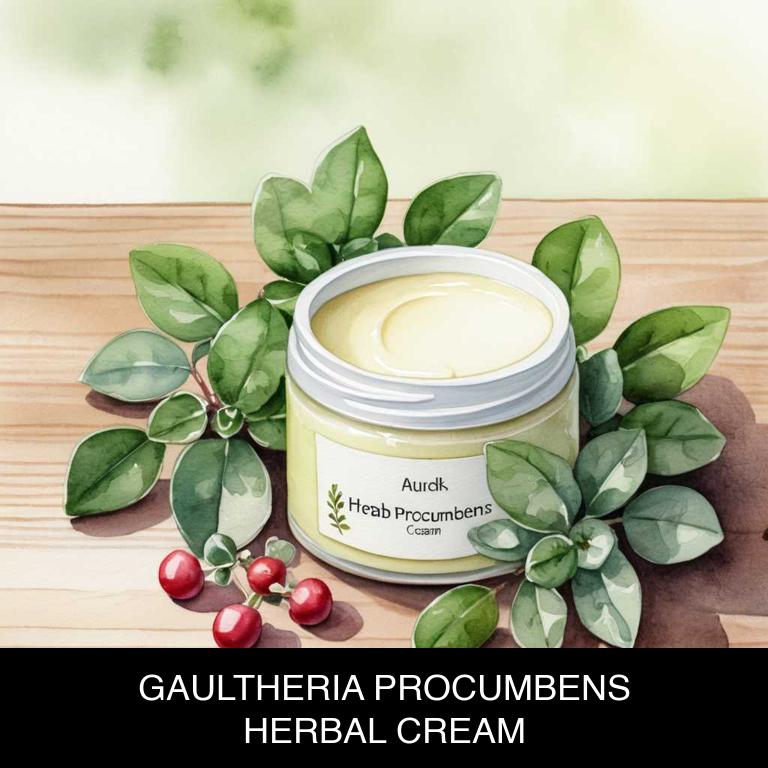
Medicinal Constituents
The list below shows the primary medicinal constituents in Gaultheria procumbens creams that help with foot pain.
- Gaultherin: This phenolic compound has anti-inflammatory properties, which help reduce pain and swelling in the feet caused by injuries or conditions like plantar fasciitis.
- Iridoids: As a type of terpenoid, iridoids have analgesic and anti-inflammatory effects, making them useful for alleviating foot pain caused by conditions like arthritis or muscle strain.
- Tannins: These polyphenolic compounds possess anti-inflammatory and astringent properties, which can help reduce swelling and ease pain in the feet, making them beneficial for conditions like foot sprains or bruises.
Parts Used
The list below shows the primary parts of wintergreen used to make creams for foot pain.
- Leaves: They are used due to their high concentration of salicylic acid, a compound similar to aspirin that provides anti-inflammatory and pain-relieving properties.
- Roots: The roots are used for their rich content of glycosides, which have been shown to possess analgesic and anti-inflammatory properties.
- Barks: The barks of Gaultheria procumbens contain phenolic compounds and flavonoids, which contribute to their anti-inflammatory and pain-relieving effects, making them suitable for use in creams for foot pain.
Quick Recipe
The following recipe gives a procedure to make a basic wintergreen for foot pain.
- Harvest fresh gaultheria procumbens leaves and stems in the early morning when the dew is still present.
- Dry the harvested material in a warm area with good air circulation at 30-40c for 2-3 hours.
- Combine 1 part gaultheria procumbens leaves and stems with 2 parts carrier oil such as sweet almond oil in a 1:2 ratio.
- Steep the mixture for 2-4 weeks in a cool dark place allowing the herbal extract to infuse.
- Strain the mixture and whip 100g of the infused oil with 50g of beeswax and 20g of shea butter until smooth.
5. Melaleuca alternifolia
Melaleuca alternifolia, also known as tea tree, creams helps with foot pain because of its anti-inflammatory and antiseptic properties.
The active ingredients in tea tree creams, such as melaleuca oil, penetrate deep into the skin, reducing swelling and inflammation associated with foot pain. This natural remedy also helps to promote healing and reduce the risk of infection, making it an effective treatment for various foot conditions, including athlete's foot and plantar fasciitis.
Regular application can provide long-lasting relief.

Medicinal Constituents
The list below shows the primary medicinal constituents in Melaleuca alternifolia creams that help with foot pain.
- Cineole: Helps to reduce inflammation and relieve pain in the foot by acting as a natural analgesic and anti-inflammatory agent.
- Methyl eugenol: Eases pain and discomfort in the foot by reducing inflammation and acting as a natural analgesic and anti-arthritic agent.
- Cymene: Reduces pain and swelling in the foot by acting as an anti-inflammatory and analgesic agent, and also by reducing oxidative stress.
Parts Used
The list below shows the primary parts of tea tree used to make creams for foot pain.
- Leaves: They contain high levels of tea tree oil, which is known for its anti-inflammatory and antiseptic properties that help reduce pain and inflammation in the feet.
- Rhyzomes: They are rich in terpenoids, which have anti-inflammatory and analgesic properties that help to soothe and calm foot pain.
- Seeds: They contain a compound called melaleuca, which has been found to have anti-inflammatory properties that can help to reduce pain and swelling in the feet.
Quick Recipe
The following recipe gives a procedure to make a basic tea tree for foot pain.
- Harvest 20-30 fresh leaves from the plant and chop them into small pieces to release their oil.
- Combine 1 cup of chopped leaves with 2 cups of carrier oil in a clean glass jar to infuse.
- Steep the mixture in a cool dark place for 2-3 weeks to allow the oil to extract.
- Strain the mixture through a cheesecloth into a clean container to separate the oil from the solids.
- Mix the infused oil with 1/2 cup of beeswax and 1/4 cup of shea butter to create a smooth cream.
6. Mentha x piperita
Mentha x piperita, also known as peppermint, creams helps with foot pain because of its anti-inflammatory and cooling properties.
The menthol in peppermint creams can help numb the affected area, reducing discomfort and pain. Additionally, peppermint's anti-inflammatory compounds help reduce swelling and inflammation in the foot, making it an effective remedy for conditions such as plantar fasciitis and heel pain.
Its refreshing scent also helps to promote circulation and relaxation, further aiding in the relief of foot pain.

Medicinal Constituents
The list below shows the primary medicinal constituents in Mentha x piperita creams that help with foot pain.
- Menthol: Menthol helps with foot pain by providing temporary relief through its analgesic and anti-inflammatory properties, which numb the area and reduce pain perception.
- Menthone: Menthone contributes to the reduction of pain and inflammation in the feet by exhibiting anti-inflammatory and antispasmodic effects, which help relax muscles and reduce swelling.
- Cineole: Cineole helps alleviate foot pain by acting as a natural anti-inflammatory agent, reducing inflammation and swelling in the affected area, and providing a cooling sensation to soothe the skin.
Parts Used
The list below shows the primary parts of peppermint used to make creams for foot pain.
- Leaves: High in menthol, which provides a cooling sensation and helps to relieve pain and inflammation.
- Stems: Contain a high concentration of menthol and other compounds that contribute to the analgesic and anti-inflammatory properties of the plant.
- Roots: Rich in menthone, a compound that has been shown to have pain-relieving and anti-inflammatory effects, making it useful in topical creams for foot pain.
Quick Recipe
The following recipe gives a procedure to make a basic peppermint for foot pain.
- Harvest 200g of fresh mentha x piperita leaves from the garden in the early morning to ensure peak potency.
- Combine the harvested leaves with 500ml of distilled water in a saucepan and gently heat to 60°c for 10 minutes.
- Strain the mixture through a cheesecloth into a clean bowl to separate the liquid from the solids.
- Mix 100g of beeswax and 100g of coconut oil in a double boiler and heat until the mixture reaches 40°c.
- Combine the infused liquid from step 3 with the melted wax and oil mixture from step 4 and whip until thickened.
7. Myristica fragrans
Myristica fragrans, also known as nutmeg, creams helps with foot pain because of its potent anti-inflammatory and analgesic properties.
The active compounds in nutmeg, such as myristicin, work to reduce swelling and ease discomfort in the feet, providing relief from conditions like plantar fasciitis and athlete's foot. Additionally, the moisturizing properties of nutmeg creams help to soften and hydrate the skin, promoting healthy foot care and reducing the risk of irritation and dryness.
This makes nutmeg creams a natural and effective remedy for foot pain.

Medicinal Constituents
The list below shows the primary medicinal constituents in Myristica fragrans creams that help with foot pain.
- Monoterpenes: They help with foot pain by reducing inflammation and providing analgesic properties, which can provide relief from pain and discomfort in the feet.
- Phenolic compounds: These compounds have anti-inflammatory and antioxidant properties, which can help to reduce swelling and soothe the skin, providing relief from foot pain and promoting faster healing.
- Myristicin: It has analgesic, anti-inflammatory, and antioxidant properties, which can help to reduce pain and inflammation in the feet, and also promote the healing of damaged tissues.
Parts Used
The list below shows the primary parts of nutmeg used to make creams for foot pain.
- Seeds: Used for their analgesic and anti-inflammatory properties to help relieve foot pain.
- Buds: Used for their warming and analgesic effects to reduce pain and inflammation in the feet.
- Fruits: Used for their antioxidant and anti-inflammatory properties to soothe and calm foot pain and inflammation.
Quick Recipe
The following recipe gives a procedure to make a basic nutmeg for foot pain.
- Gather 500g of myristica fragrans seeds, 200g of beeswax, 100g of coconut oil, and 100g of shea butter.
- Combine 200g of myristica fragrans powder with 20g of vitamin e oil in a double boiler.
- Mix 100g of beeswax and 100g of coconut oil in a separate saucepan over low heat for 10 minutes.
- Combine the myristica fragrans mixture with the beeswax mixture and stir until the mixture reaches 40 degrees celsius.
- Pour the mixture into containers and let it cool and solidify for 30 minutes.
8. Pinus sylvestris
Pinus sylvestris, also known as scots pine, creams helps with foot pain because of its anti-inflammatory and analgesic properties.
The natural compounds found in the extract of Pinus sylvestris, such as pinosylvin and pinobanksin, have been shown to reduce swelling and ease discomfort in the feet. By applying the cream topically, it can help to relax tense muscles and soothe irritated skin, providing relief from common foot issues like plantar fasciitis and athlete's foot.
This natural remedy can be a safe and effective way to find comfort from foot pain.
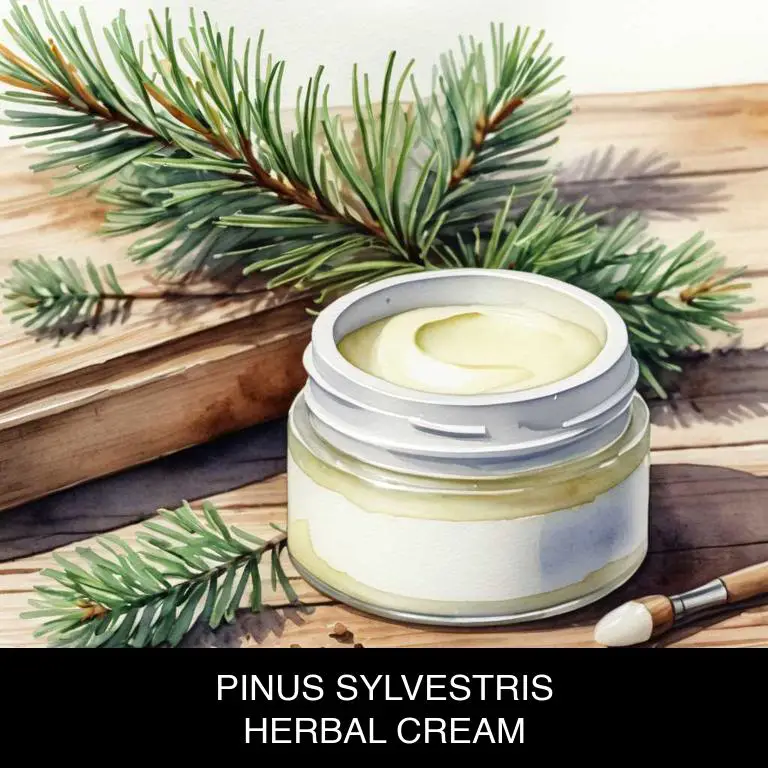
Medicinal Constituents
The list below shows the primary medicinal constituents in Pinus sylvestris creams that help with foot pain.
- Α-pinene: This terpene has anti-inflammatory properties, which help reduce swelling and pain in the feet by blocking the production of pro-inflammatory enzymes.
- Pinosylvin: This phenolic compound has antimicrobial and anti-inflammatory effects, which help prevent infections and reduce inflammation in foot injuries or conditions, thereby alleviating pain.
- Sabinene: This terpene has analgesic and anti-inflammatory properties, which help numb the pain and reduce inflammation in the feet, providing relief from discomfort and soreness.
Parts Used
The list below shows the primary parts of scots pine used to make creams for foot pain.
- Resins (obtained from buds): Used because they contain terpenes that have analgesic and anti-inflammatory effects, which help in reducing foot pain.
- Sap (obtained from buds and stems): Used due to its anti-inflammatory and antiseptic properties that help in reducing swelling and pain in the feet.
Quick Recipe
The following recipe gives a procedure to make a basic scots pine for foot pain.
- Harvest 50g of dried pinus sylvestris leaves and stems from a trusted supplier or forage in a sustainable manner.
- Grind the pinus sylvestris into a fine powder using a mortar and pestle for 10 minutes.
- Combine the powdered pinus sylvestris with 100g of distilled water in a double boiler and heat for 30 minutes.
- Strain the mixture through a cheesecloth and discard the solids to obtain a clear liquid extract.
- Mix 20g of beeswax and 10g of sweet almond oil with the pinus sylvestris extract in a heat-proof bowl and stir until smooth.
9. Salix alba
Salix alba, also known as white willow, creams helps with foot pain because it contains salicin, a natural anti-inflammatory compound similar to aspirin.
The anti-inflammatory properties of salicin reduce swelling and ease pain in the feet, making it an effective treatment for conditions such as plantar fasciitis and athlete's foot. Additionally, the cream's soothing and moisturizing properties help to calm and hydrate the skin, reducing discomfort and promoting healing.
This makes Salix alba creams a popular natural remedy for foot pain relief.
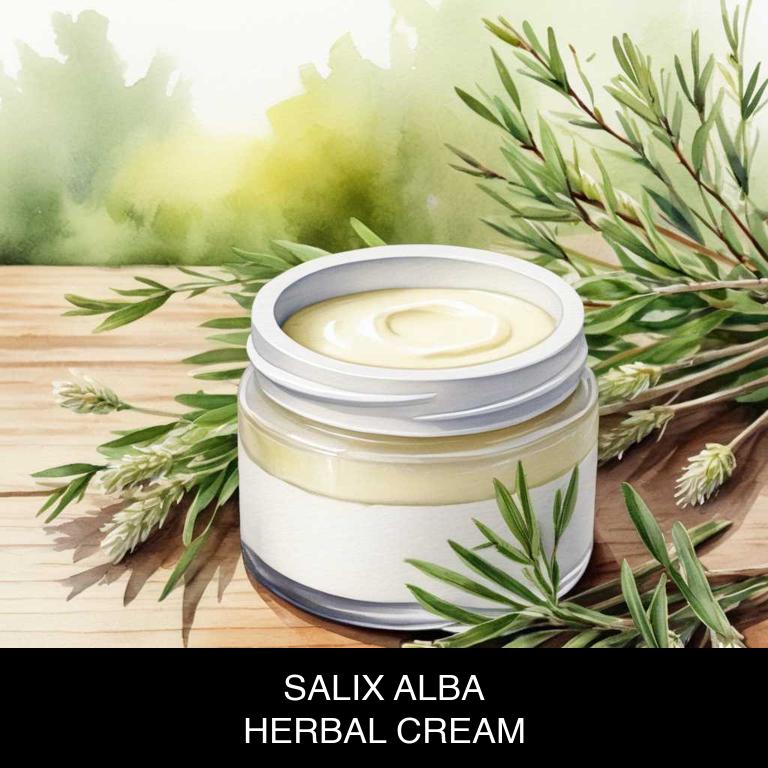
Medicinal Constituents
The list below shows the primary medicinal constituents in Salix alba creams that help with foot pain.
- Salicylic acid: It helps with foot pain by acting as a topical analgesic and anti-inflammatory agent, reducing swelling and pain in the affected area.
- Glucoquinone: It is a phenolic compound with anti-inflammatory and antioxidant properties that help to reduce pain, inflammation, and oxidative stress associated with foot pain.
- Salicortin: It is a triterpenoid saponin with anti-inflammatory and analgesic properties that help to reduce pain and swelling in the feet by inhibiting the production of pro-inflammatory enzymes.
Parts Used
The list below shows the primary parts of white willow used to make creams for foot pain.
- Leaves: Salix alba leaves are often utilized for their analgesic and anti-inflammatory properties, which help reduce pain and inflammation in the affected area.
- Buds: Salix alba buds are sometimes used for their astringent and anti-inflammatory properties, which help to reduce swelling and promote healing in the skin.
Quick Recipe
The following recipe gives a procedure to make a basic white willow for foot pain.
- Weigh and mix 100g of salix alba bark with 500ml of distilled water in a saucepan.
- Heat the mixture over low heat for 20-30 minutes or until the liquid reduces by half slowly.
- Strain the mixture through a cheesecloth into a clean container discarding the solids carefully.
- Combine the strained liquid with 100g of beeswax and 50g of shea butter in a separate saucepan.
- Heat the mixture over low heat, stirring constantly, until the wax and butter melt and blend smoothly.
10. Sambucus nigra
Sambucus nigra, also known as elder, creams helps with foot pain because of its anti-inflammatory and antispasmodic properties.
The cream is made from the berries and flowers of the Sambucus nigra plant, which have been used for centuries to relieve pain and reduce inflammation. By applying the cream to the affected area, it can help to reduce swelling, ease muscle cramps, and soothe soreness, providing quick and effective relief from foot pain.
This makes it a popular natural remedy for foot pain sufferers.
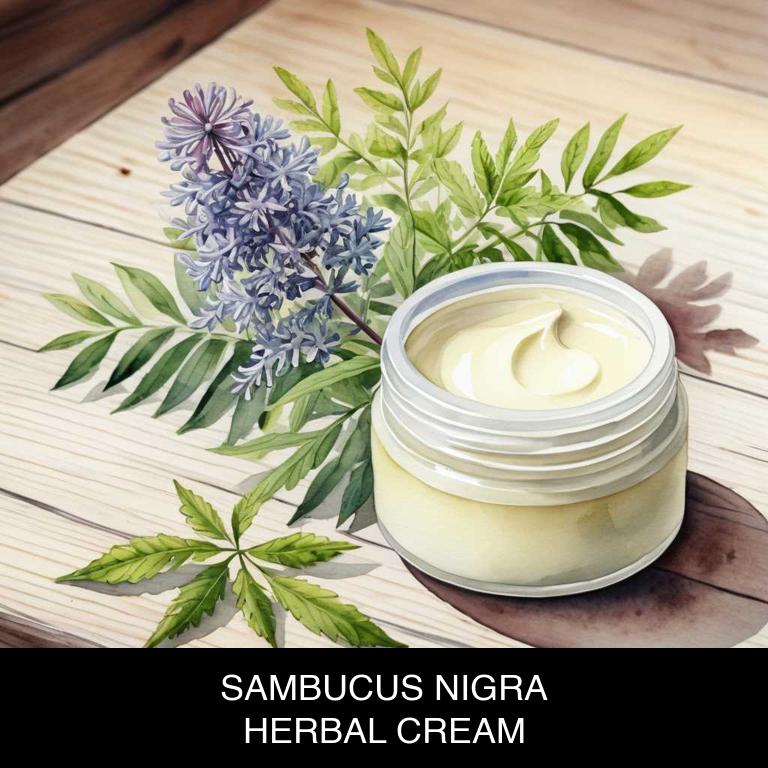
Medicinal Constituents
The list below shows the primary medicinal constituents in Sambucus nigra creams that help with foot pain.
- Flavonoids: These plant compounds help reduce inflammation and pain by inhibiting the production of pro-inflammatory enzymes, which can contribute to foot pain.
- Antimicrobial phenolics: These compounds help prevent infections that can cause or exacerbate foot pain, such as fungal or bacterial infections, by inhibiting the growth of microorganisms.
- Volatile oils: The terpene content in Sambucus nigra creams may help reduce pain and inflammation by acting as a natural analgesic and anti-inflammatory agent.
Parts Used
The list below shows the primary parts of elder used to make creams for foot pain.
- Flowers: The flowers are used due to their high concentration of flavonoids and other compounds that have anti-inflammatory and analgesic properties.
- Leaves: The leaves are used because they contain saponins, which have anti-inflammatory and antiseptic properties that can help soothe and calm foot pain.
- Barks: The barks are used due to their high content of salicylic acid, a natural pain reliever and anti-inflammatory agent that can help reduce foot pain.
Quick Recipe
The following recipe gives a procedure to make a basic elder for foot pain.
- Harvest 10-20 grams of fresh sambucus nigra flowers in late spring and early summer when they are in full bloom.
- Combine the harvested flowers with 100ml of carrier oil such as sweet almond oil in a clean glass jar.
- Allow the mixture to infuse in a cool dark place for 4-6 weeks shaking the jar every few days.
- Strain the infused oil through a cheesecloth or a coffee filter into another clean glass container.
- Mix 20-30 grams of beeswax with the strained oil and heat the mixture gently until the beeswax melts to create a creamy texture.
What is the best combination of herbal creams to use for foot pain?
The best combination of herbal creams that help with foot pain is a blend of arnica, peppermint, and tea tree oil creams.
Arnica cream reduces inflammation and swelling, while peppermint cream cools and soothes the skin. Tea tree oil cream has antibacterial properties that prevent infection and promote healing. Apply a layer of arnica cream to reduce inflammation, followed by peppermint cream to cool, and finish with a thin layer of tea tree oil cream to prevent infection.
This combination helps to alleviate foot pain and discomfort.
What ailments similar to foot pain are treated with herbal creams?
Ailments similar to foot pain that are treated with herbal creams are various skin issues, such as eczema, acne, and psoriasis.
Herbal creams containing ingredients like aloe vera, tea tree oil, and chamomile are used to soothe irritated skin, reduce inflammation, and promote healing.
Additionally, conditions like arthritis, muscle strains, and sprains can also benefit from topical herbal treatments, providing relief from pain and stiffness while promoting relaxation.